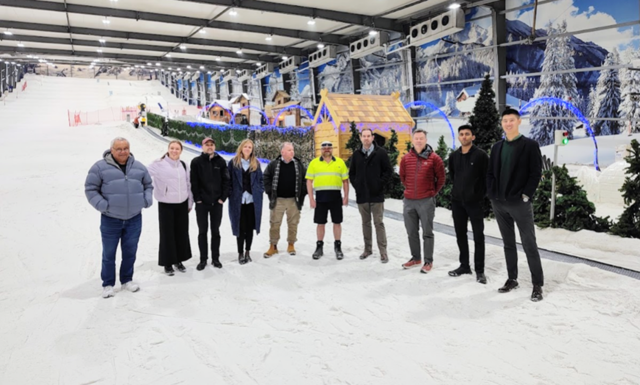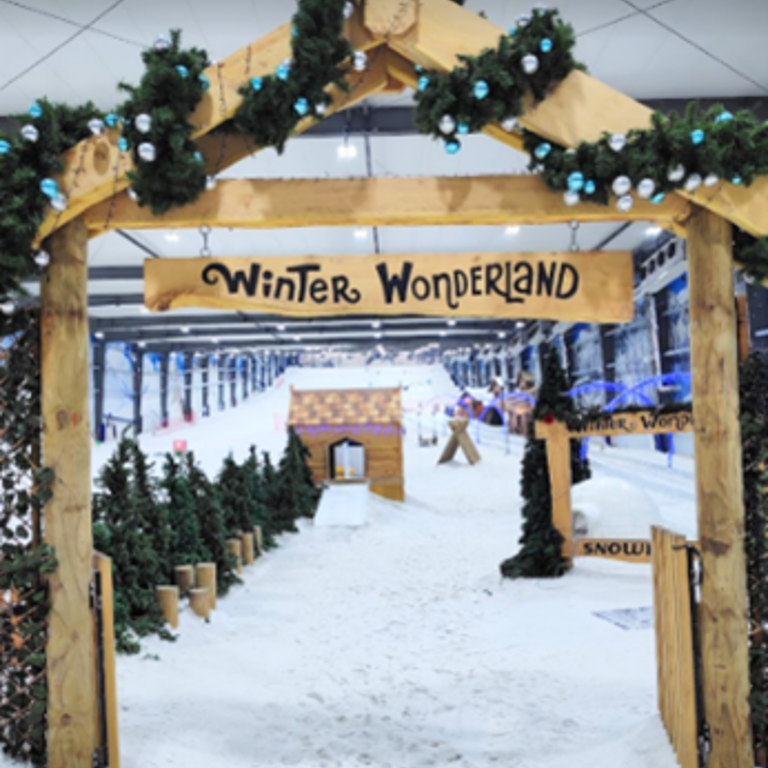On the 13th August, a small group of engineers enjoyed a ‘Behind the Scenes’ visit to ‘Snowplanet’ in Silverdale, Auckland. From the outside, the sleek 8000m2 white structure looks like an elongated plane hangar precariously hugging the hillside.
‘Snowplanet’ in Silverdale, Auckland. From the outside, the sleek 8000m2 white structure looks like an elongated plane hangar precariously hugging the hillside.
Our group were met by Snowplanet’s affable maintenance manager, Dave Simpson, who is responsible for ensuring that the snow quality, climate control, and overall ambient conditions are consistent with the year-round winter experience. Before the tour commenced, we were given an opportunity to quiz Dave and given his knowledge on the mechanical side, we were somewhat surprised to learn that he came from a software background.

It’s therefore not surprising that his first input into Snow Planet was to install a new communication protocol. He chose ‘LoRaWan’ (LoRa short for Long Range) wireless technology, consisting of a series of sensors on the ski slope that could provide real-time temperature data.
In 2005, Snowplanet opened its doors to the public, bringing snowboarding and skiing opportunities within 35 km of Auckland. It has also put New Zealand on the map as Snow Planet is the only indoor ski venue currently operating in the Southern Hemisphere. Whilst no manmade structure can truly emulate the backdrop of New Zealand’s majestic ski fields, Snowplanet does a pretty good job, once inside. From snow level to ceiling, poster wallpaper depicting an alpine scene covers the sides for the of the ski slope for its full length adding to the wintery feel.
The concept of creating manmade snow for an indoor environment is not new, its roots can be traced back to Vienna 1927. Early methods involved mixing crushed washing soda or similar crystals with a filling material (sawdust or wood pulp) in the proportion of 65 per cent crystal, 28 per cent fillers and water. Not real snow, but it served a purpose!
 Snowplanet produces man-made snow — but the real stuff, genuine frozen water crystals — with an additive called ‘snomax’ containing active plant bacterium that initiates ice-nucleation. It improves efficiency in marginal weather and makes consistent snowmaking viable indoors. The snow making process uses atomised water frozen by cold air, the same physical process as natural snowfall. The only difference is snomax, allows droplets to begin freezing at higher subzero wet-bulb temperatures (typically –2 to –3°C instead of needing –6°C or lower).
Snowplanet produces man-made snow — but the real stuff, genuine frozen water crystals — with an additive called ‘snomax’ containing active plant bacterium that initiates ice-nucleation. It improves efficiency in marginal weather and makes consistent snowmaking viable indoors. The snow making process uses atomised water frozen by cold air, the same physical process as natural snowfall. The only difference is snomax, allows droplets to begin freezing at higher subzero wet-bulb temperatures (typically –2 to –3°C instead of needing –6°C or lower).
In terms of production volumes, in marginal conditions (–2°C to –4°C wet bulb), Snomax can increase snow yield by 20–50% per litre of water, depending on humidity, droplet size, and gun design. In colder conditions (–6°C and below), the additive has little to no measurable benefit because droplets would freeze efficiently without it. Snomax accelerates crystal formation so the snow can fully develop within the limited air space of the dome. Silverdale’s Snowplanet can produce 17m3 - 25m3 cube within a 4-hr session — enough to allow to skiers and snowboarders to hone their skills on its 200-meter slope.
The 300 mm polystyrene walls and roof insulate the building, keeping the warmth out and the cold air inside. The environment has a temperature control split of 1.5 °C running from North to South. Walking out the restaurant onto the snow soon had us all thrusting out hands deep into puffer jackets, whilst our host, clad in a sleeveless shirt and shorts explained the snow making process…. the antithesis of ‘Mad Dogs and Englishmen go out in the midday sun’ comes to mind!


Facts:
Producing 4000m3 of snow a year takes a lot of electrical power – roughly 3 Megawatts. Daily water consumption is between 10 – 20 m3. Glycol is stored on site in a 8000 L tank alongside 650 L tank of ammonia. Air filtration is 20 microns.
One of the issues with snow is keeping it in one place. The snow ploughs push the artificial snow towards the north and south walls whilst the snow naturally gravitates east-west towards the restaurant before arresting upon a series of ‘Fall-Pac’ (polystyrene fill) landing bags. When the snow is replenished, it is simply taken out to melt into the grass.
With climate change projections from the National Institute of Water and Atmospheric Research (NIWA) indicating snow fall decreasing over time, Snow Planet will allow skiers and snowboarders to continue to enjoy their sport for years to come.
 About the Author:
About the Author:
Les Wilson is Chartered Eng and CIBSE Fellow. He works for Mott MacDonald in their Auckland Head Office as their Principal Public Health / Hydraulic Engineer.
